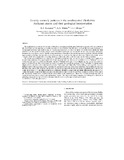| dc.description.abstract | The granite-greenstone terrain of south-central Zimbabwe, encompassing the Belingwe (Mberengwa) greenstone belt and sections of
the Great Dyke, provides important constraints on models for the evolution of the Zimbabwe craton and the Archaean crust in general.
In this paper we enhance and model existing and recently acquired gravity data from the region and correlate the anomalies and their
derivatives with the known basement geology to evaluate models for greenstone belt development. We also study the spatial gneiss-granite-
greenstone association in general, and the geologic implications of models of the anomaly patterns in particular. Although the Belingwe
greenstone belt has been mapped, its subsurface geometry is poorly known. Similarly, the Great Dyke is well studied, but no
systematic study of the extent and cross-cutting relations of other mafic dykes in the Archaean crust has been undertaken.
The regional gravity field shows no evidence for crustal thickness variations in the area and the gravity anomalies can be explained by
lateral density variations of the supracrustal rocks. Prominent gravity highs are observed over the high density (≤ 3000 kg/m3) volcanosedimentary
piles (greenstone belts) and ultramafic complexes. Well-defined elongate, sub-oval/elliptical gravity lows are associated with
intrusive granitic plutons. The granite-greenstone contacts are marked by steep gravity gradients of up to 5 mGal/km that imply steeply
dipping or near-vertical contacts for the anomalous bodies. This is tested and confirmed by 2½D modelling of gravity profiles across the
Belingwe and Fort Rixon greenstone belts, constrained by measured densities and observed geological data. The modelling also indicates
that these belts, and possibly all the belts in the study area (based on comparable densities and anomaly amplitudes), have limited depth
extents in the range of 3–5 km. This is comparable to thicknesses obtained elsewhere from deep seismic reflection data and geoelectrical
studies, but mapped stratigraphic thicknesses give a maximum depth extent of about 9.5 km. Present studies and previous work support
the idea that the volcanics were extruded within rift zones and laid on older granitic crust, followed by subsidence and rapid deposition of
sediments that were sourced from the adjacent basement terrains. The volcano-sedimentary sequences were subsequently deformed by
intruding younger plutons and affected by late-stage strike-slip activity producing cross-cutting structures. | en |

